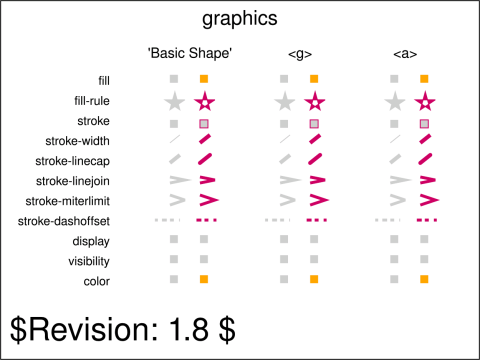animate-elem-78-t |
|
| SVG Image | PNG Image |

|
|
|
||||||||
This test demonstrates how <set> elements change graphics properties on elements from the 'Basic Shapes' chapter. For each of the graphics properties being tested, 3 <set> animations are applied. The first <set> element acts directly on 'Basic Shape' elements. The second <set> element acts on a <g> containing children. The third <set> element acts on an <a> containing children. In each case the test validates that the animated value set on the <g> and <a> elements is inherited by the 'Basic Shape' element. All the <set> elements have a begin attribute set to 0s with an offset of 1s after the end. So, the animation will apply 1s after the document is loaded and will repeat every 1s after the animation ends.
The first <set> validates the fill property, with fill set to orange. When applied directly to the 'Basic Shape' element, the <rect> fill value will change to orange when it is translated to the right every 1s. When applied to the <g> and <a> elements, the <rect> inherits the fill value and is orange.
The second <set> validates the fill-style property, with fill-style set to evenodd. When applied to the 'Basic Shape' element, the <polyline> fill-style is changed from nonzero to evenodd. When applied to the <g> and <a> elements, the <polyline> inherits the evenodd fill-style.
The third <set> validates the stroke property. In this case fill is set to none. When stroke is applied to the 'Basic Shape' element, the <rect> on the right appears with the stroke color. When applied to the <g> and <a> elements, the <rect> inherits the stroke property.
The fourth <set> validates the stroke-width property, with stroke-width set to 4. When stroke-width is applied to the 'Basic Shape' element, the <line> on the right has a width of 4. When applied to the <g> and <a> elements, the <line> inherits the stroke-width.
The fifth <set> validates the stroke-linecap property, with stroke-linecap set to round. When stroke-linecap is applied to the 'Basic Shape' element, the <line> stroke-linecap value switches from butt to round. When applied to the <g> and <a> elements, the <line> inherits the square stroke-linecap.
The sixth <set> validates the stroke-linejoin property, with stroke-linejoin set to bevel. When stroke-linejoin is applied to the 'Basic Shape' element, the <line> stroke-linejoin value switches from miter to bevel. When applied to the <g> and <a> elements, the <line> inherits the bevel stroke-linejoin.
The seventh <set> validates the stroke-miterlimit property, with stroke-miterlimit set to 10. When stroke-miterlimit is applied to the 'Basic Shape' element, the miter-length to stroke-width ratio exceeds the miter-limit and the <polyline> switches from bevel to miter.When applied to the <g> and <a> elements,the <line> inherits the stroke-miterlimit.
The eighth <set> validates the stroke-dashoffset property, with stroke-dashoffset set to 5.5. When stroke-dashoffset is applied to the 'Basic Shape' element, the <line> has a different dashing pattern. When applied to the <g> and <a> elements, the <line> inherits the property.
The ninth <set> validates the display property, with display set to none. When display is applied to the 'Basic Shape' element, the <rect> does not appear on the right. When applied to the <g> and <a> elements, the <line> inherits the display property and hence is not seen.
The tenth <set> validates the visibility property, with visibility set to hidden. When visibility is applied to the 'Basic Shape' element, the <rect> is hidden on the right. When applied to the <g> and <a> elements, the <line> inherits the visibility property and hence is not seen.
The eleventh <set> validates the color property, with color set to blue. When color is applied to the 'Basic Shape' element, the <rect> on the right switches from default color of black to blue. When applied to the <g> and <a> elements, the <line> inherits the color property.